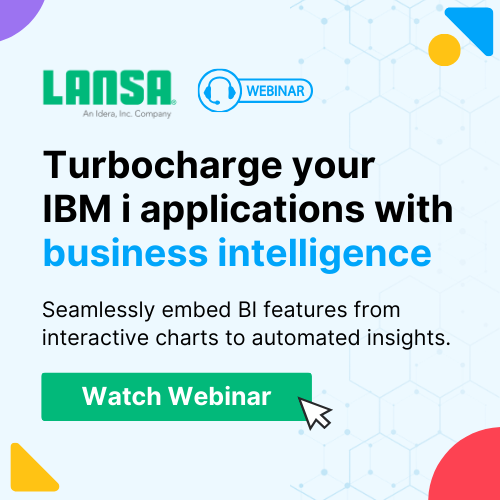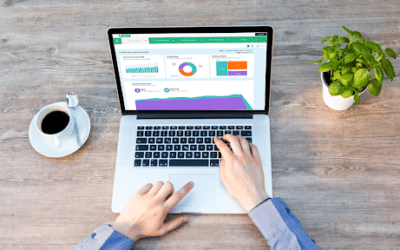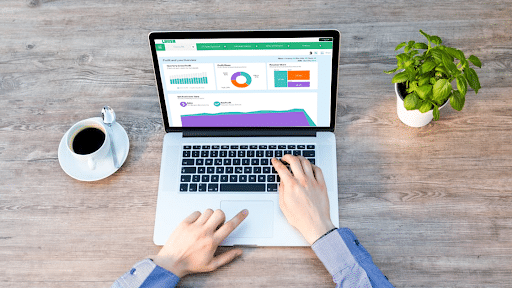AI’s ability to analyze data and use it to make recommendations makes it a natural fit for business intelligence (BI). At the same time, it can be challenging to understand exactly how AI benefits BI and specific use cases for integrating it into your BI analysis. This is your guide to understanding the impact of AI on BI, and how you can start using it in your business intelligence workflow.
Key Insights
- An AI-powered system can learn on its own, gradually improving its analysis as you feed it more data.
- You can use AI to reduce risk, boost efficiency, manage your supply chain, better understand customers, and more
- LANSA BI leverages AI by enabling users to make data-powered decisions that drive business improvements
Benefits of AI for Business Intelligence
AI supports your BI system by enabling you to work with more data and enabling more complex, flexible analysis.
Analytics on More Diverse, Larger Data Sets
AI makes it possible to analyze a wider range of data in your BI system [1]. For example, instead of merely analyzing text and .csv files, you can use AI to draw insights from:
- Images
- Videos
- Audio files
- Unstructured data from survey responses
You can also feed data from an IoT system or social media into an AI-powered analysis tool. As a result, your business gets access to more data, which puts you in a better position to make sound decisions.
Fast, Complex Analysis
AI can detect patterns and deliver insights by analyzing large data sets — quickly and accurately. They use parallel processing, which refers to breaking down large workloads into smaller parts and then completing the work on each part in “parallel” or simultaneously. As a result the computational process takes less time than it would for a system using a linear approach on the entire data set.
AI systems use graphics processing units (GPUs) to run complicated calculations faster than normal processors. This means businesses can reap AI-generated insights in real-time by integrating data from multiple business apps.
Adaptive Performance
You don’t have to explicitly train an AI model to improve its performance. It can improve the accuracy of its performance on its own. This makes them capable of delivering more value over time. Therefore, much like a diligent, focused human employee, an AI can get better day by day.
Using Predictive Insights to Power Proactive Decisions
An AI system can analyze historical performance data and juxtapose it with current outcomes. It can then use this information to recommend ways to improve business performance.
For instance, you can use AI to analyze past sales performance data. You can then give it current performance data and a sales goal. The system can then use this data to tell you how likely your company is to achieve its sales goals. It can even recommend changes you can make to achieve your objectives either on time or sooner.
Regardless of whether you choose to use AI to provide advice, the data it produces puts you in a strong position to meet future demands, build solutions that align with customer demands, and more.
AI vs. Traditional Business Intelligence
| Feature | Traditional BI | AI-Powered BI |
| Data analysis | Manual and descriptive | Automated and predictive and/or prescriptive |
| Data integration | Limited and manually performed | Your BI engine automatically pulls data from other systems |
| Cost | Labor-intensive, which raises costs | Relatively inexpensive due to subscription-based pricing |
| User experience | Multiple screens showing disparate charts, graphs, and sheets | Centralized consoles that automatically render analytical tools |
| Time | Time-consuming due to manual processes | Relatively quick because a computer automatically generates insights |
While AI has many uses across creative, analytical, and functional domains, it’s transforming BI in three principal ways via descriptive, predictive, and prescriptive analytics. Here’s how each of these work:
Descriptive Analytics
Descriptive analytics enables an AI system to describe what has happened [2]. For instance, an AI-powered descriptive analytics solution can:
- Summarize historical data
- Interpret historical data
- Identify trends and patterns across your data.
In this way, AI makes it easier to understand, interpret, and use even very complex datasets. For example, you can simply have your AI-powered BI tool summarize a trend in yearly sales figures. It can explain the trend in simple terms that you can then use during a presentation or a one-on-one meeting.
LANSA BI is one example of a powerful descriptive analytics tool. LANSA BI gives you standard reporting features, dashboards, and scorecards, providing assisted insights generation that improves business performance. You can also use LANSA BI’s assisted insights to explain data and compare it alongside other data. With this feature, you get a descriptive analytics solution that adds easy-to-understand analysis to accompany rich, interactive graphics.
Predictive Analytics
Predictive analytics involves calculating the probability of something happening in the future [3]. Some common uses include:
- Performing demand forecasts
- Assessing risk
- Improving operational efficiency
- Optimizing your supply chain
To illustrate, you can use natural language query (NLQ) to ask an AI analytics app, “Which products will generate the most revenue in October 2025?” With guided NLQ, the system provides you with language, such as “products,” “most,” and “revenue” and then aligns them with the categories in the database you’re querying before providing you with the data you need.
Prescriptive Analytics
Prescriptive analytics describes actions you can take to make a future outcome more likely [4]. For instance, a prescriptive analytics system can:
- Tell an IT company which help center staff to employ to maximize positive outcomes for employees
- Use a yearly sales goal to advise a manufacturer which products to produce, how many, and how to price them—all in a way that helps the company reach its revenue milestones
- Tell an insurance company which companies it should raise rates on to reduce the impact of expensive claims over the next year
How Is AI Transforming BI?
AI is transforming BI by producing automated, actionable insights in less time and for less money.
Faster, Easier Analysis
With traditional BI, you may have to spend hours or days designing Excel spreadsheets that surface insights. But with AI-powered BI solutions, you can simply feed it your data and wait a few moments for its output.
More Flexible Querying
AI systems are pulling the business world away from the restrictive queries traditional BI forces you to rely on. AI-built BI solutions enable you to query your system in a number of ways instead of having to rely on prescribed queries. For example, with an NLQ-based system, you can ask your solution questions like, “What was our profit-to-overhead ratio last year?” Then, a minute later, you can ask, “Which products had the highest profit margins?”
Lowering the BI Barriers of Entry
As AI transforms the way people build BI systems, some tools also make the building process easier. As a result, a wider range of employees can construct BI solutions, especially if you use low-code tools. A sales associate can click and drag their way to a system that tells them which clients produce the most revenue in comparison to the hours the rep spends cultivating each sale. With a little training up front, regular employees can build systems with minimal IT intervention.
Applications of AI in Business Intelligence
While the number of applications of AI in business intelligence is virtually unlimited, here are some of the more common use cases:
Managing Risk and Opportunity
An AI system can use competitive intelligence to help your organization monitor the risks presented by your competition. For example, it can monitor new product launches, pricing adjustments, customer sentiment toward your competition’s products, and marketing campaigns.
Then, you can use this information to identify opportunities to succeed where your competition may be falling short — or other ways to leverage knowledge of their tactics.
Detecting Inefficiencies and Recommending Solutions
You can use AI to generate digital replicas of physical systems, model their operations, and then use prescriptive analytics to tell you how to boost efficiency.
For instance, an AI system could monitor the energy generated by a solar-powered vehicle’s solar panels in different driving conditions. It can then tell you the optimal size solar panel to use to get the best performance in different regions of the country.
Using Intelligent Process Automation
Intelligent process automation can reduce the number of resources needed to perform repetitive or routine tasks. For instance, using document intelligence, an AI system can pull insights and data from PDFs. You can then use the data it surfaces to automate a data entry process, such as filling out a form or populating a spreadsheet. This can significantly cut down on the time it takes to generate and use these documents in your business intelligence system.
Supply Chain Management
A business intelligence strategy enabled with AI can detect outliers and anomalies in your supply chain data. Highlighting this information puts you in a position to identify and rectify problems before they have a significant impact on your shipping and fulfillment costs.
You can also use AI in your supply chain by having the system automatically tell you when inventories are getting too low or to outline the most efficient methods of shipping materials. It can, for example, figure out the most cost-effective shipping channel for goods that have to go from L.A. to New York in a week or less.
Boosting Employee Productivity
Your AI-powered BI solution can analyze employee data while keeping track of how their performance fluctuates over time. For instance, it can recognize when an employee’s performance starts to slip and tell you the kinds of tasks they are struggling with. You can then use this information to provide encouragement, training, or even a much-needed break.
Dynamic Pricing
With AI, you don’t have to give every customer the same discount, hoping it encourages them to make more purchases. Instead, you can program an AI model that decides how you should price individual items based on customer buying patterns [5]. You can also use AI to determine how much of a discount a customer should get based on how much they spent the previous year or quarter.
In addition, instead of waiting until the end of a day or week to adjust prices, you can have an AI system alter prices according to demand in real-time.
More Accurate, Automated Fraud Detection
Fraud can be hard to spot—even for a well-trained employee with years of experience. On the other hand, an AI-powered system can examine patterns in fraudulent forms, payments, and more and then automatically raise a flag when another transaction displays similar traits. This takes moments instead of hours, and you can automatically feed fraud alert data into a CRM, ERP, or other software.
Challenges of using AI in BI
Despite the many benefits, using AI in a BI context isn’t without its challenges. For example, you may have to overcome:
- Data quality. Some AI-powered tools need clean, consistent data to produce actionable results
- Cost. At times, an AI-enabled BI solution may come with a high price tag. It can also be expensive to deploy and maintain over time.
- Expertise. With some AI-powered BI tools, you need significant knowledge to get it to produce the required results.
Key Takeaways
AI and BI make excellent partners because AI has the ability to analyze data, predict what is most likely to happen in the future, and provide advice regarding how to optimize business performance. As such, an AI system can streamline the process of managing risk, making decisions around how to optimize human and other resources, and making tough business calls in real-time.
LANSA BI gives you AI-powered business intelligence using embedded analytics, NLQ, and BI dashboards—all of which combine to help you derive valuable insights. Contact us today to learn more about the potential of LANSA BI in your business intelligence strategy.
References
- Speed, efficiency, and accuracy: How AI is supercharging critical document analysis finance.yahoo.com/news/speed-efficiency-accuracy-ai-supercharging-164507263.html?
- Lawton, George. “Descriptive Analytics.” WhatIs, 10 Jan. 2022, www.techtarget.com/whatis/definition/descriptive-analytics.
- What Is Predictive AI? | IBM. 12 Aug. 2024, www.ibm.com/think/topics/predictive-ai#:~:text=Predictive%20AI%20is%20sometimes%20confused,what%20is%20likely%20to%20occur.
- Ibm. “Prescriptive analytics.” What is prescriptive analytics?, 8 Nov. 2024, www.ibm.com/topics/prescriptive-analytics.
- “Dynamic Pricing: What It Is and Why It’s Important | HBS Online.” Business Insights Blog, 10 May 2024, online.hbs.edu/blog/post/what-is-dynamic-pricing.










